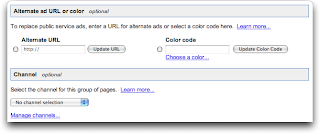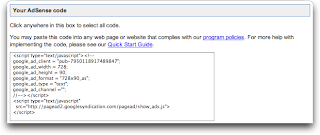I've been reading a bit about how people can make money off their Web site by joining up with the Google AdSense program, but I really don't understand how it all works. Do I need to find advertisers? Do I bill them for showing up on my site? Or does Google do all this? Thanks a million (hopefully!)
Dave's Answer:
You're not alone in being interested in the terrific Google AdSense program. Leveraging its powerful page analysis system, Google's AdSense program automatically matches the best possible advertisements with the content on your Web page, making the ads magically quite relevant to your content.
Behind the scenes, it works like this: an advertiser goes to the Google AdWords system, signs up, and creates one or more advertisements that they want to pay to have appear either on Google's search result pages or on "content pages". Those content pages are Web sites run by individuals and organizations that include AdSense, which is the "consume" side of this equation.
What makes this more interesting is that advertisers don't pay to have their adverts show up on either Google or separate content sites, but instead pay when the ads are clicked by customers, what we call "pay per click" or PPC. A percentage of the amount that the company pays Google for displaying the ad is then shared with the AdSense-enabled web site owner.
If, say, the advertiser pays $1.00 for a visitor to their site through AdWords, then Google will pay a percentage of that amount (the exactly amount has not been stated by the company) to you, perhaps $0.20, perhaps more.
I realize that $0.20 doesn't sound like much money, but if you have a few hundred visitors a week, and some percentage of them click on these adverts, you could easily make $20-$50 or much (much!) more from your site each week, without having to do any work other than add the special AdSense code to the pages in the first place.
It's simple, easy to accomplish, you never have to negotiate (or even talk) with advertisers, you don't have to bill anyone at all, and every month or two you'll get a nice little check from Google corporate. Nice!
So let's talk about the exact steps required to actually get going with the AdSense program. First and foremost, you need to sign up for the AdSense program, which you can do by clicking in the cheery button:
Note that when you sign up, you'll need to specify a Web site or weblog that you plan on incorporating AdSense: not every site is approved, however, so make sure yours has valuable and unique content and a design that doesn't include too many advertisements.
Once you're approved, it's time to log in and configure your new AdSense advertisement to include on your site!
When you first log in, you'll see the following navigational bar:

Google AdSense Navigational Bar
Click on "AdSense for Content" and you'll be ready to configure your ad. Now, don't worry: configuration is pretty easy and kinda fun too, you get to pick colors, sizes, and much more.
Once you've clicked on the "AdSense for Content" tab, your next step will be to decide what type of advertisements you want Google to serve up on your own pages:

Google AdSense Ad Types
I suggest you start out with a text "Ad unit", as shown here: the other type of content adverts are less generally useful, less flexible, and typically also have a much lower payout, according to the grapevine. When you are ready, note that you can learn more about the different formats by clicking on any of the last three lines in that view.
The next section of your task is to specify the format and layout of your AdSense ad, and there are a rather amazing number of different size and format options. Google has a helpful AdSense Ad Format Reference Page that's worth a quick peek.
Here at Ask Dave Taylor, I use a Leaderboard (728x90) on the top of the home page and a Large Rectangle (336x280) on this very page. Your layout will inevitably be different and you might choose a different layout entirely. Further, you are allowed to have up to three different ad units on a given page, so you can experiment with them one atop the other, adjacent to each other, or interspersed with your content. Just try to remember that if there's no content, there's no page. :-)
Now that you've picked an ad layout size (and yes, you can change it at any time too) it's time to have the most fun: changing the color scheme of the ad itself. My handy tip: use a border color that's the same as the background color of your page (as I do on this page) so that it's less overt that the ads are actually advertisements. It helps people not gloss over them and, hopefully, click on the ads a bit more frequently.
The built-in color schemes are nice too, of course, if you want to use them, but just as with the sizes, I strongly recommend that you experiment with different color schemes and see if you get a better percentage of clickthrus and greater revenue. Perhaps every Sunday night you can change to another color scheme and then track week-by-week what works best?
The next step is to specify an alternate Ad URL or color, and a specific channel for your ad:

Google AdSense Channels
The idea behind alternate ads is that sometimes no advertisers have bid on advertising for the keywords, leading Google to a pickle: what to display? By default, it instead displays public service ads (PSAs), but if you want to create an HTML snippet that produces the same size content, you can use that instead, or, you can simply have a solid box in the color of your choice that blends into the design of your site.

I am a much stronger supporter of channels, however. Channels let you organize your AdSense results by Web site (if you have more than one site) or by areas of your site. On this site, for example, I have a channel for "home page leaderboard" and another for "large rectangle" so I can compare how each format is doing, rather than just guessing in the aggregate. It's much easier to start correctly than to retrofit this sort of thing, so take the time and set up a basic channel or two to begin categorizing your results.
Finally, you've made all the settings you need and it's time to grab the HTML snippet that'll generate the ad block on your own site!
Google AdSense Ad Code
Your specifics will be a bit different from what you see in this screen shot, but the code will generally look identical. Just select all the text in the box, then use Edit --> Copy to get that code into your copy/paste buffer.
Now open up a page where you'd like to include the AdSense code, or a template if you're working with something like a weblog system, and paste in the new code by using Edit --> Paste.
Save your template and rebuild your site, or, if it's just a page, save the page back onto the server and bring it up in your web browser. That's it!
Important Warning: do not click on your ads!
I think one of the most common mistakes that new AdSense participants make is to click on an advert or three to "make a quick buck". Sounds good in theory, but you'll end up kicked out of the AdSense program if you click on ads shown on your own pages, which is not a good strategy for earning money!
Anyway, that's the basic set of steps. Don't delay and don't wait for tomorrow: pop back up to the beginning of this article to sign up for AdSense, then go through these steps and you can start turning your cost center of a Web site into a revenue generation system, modest or otherwise!
.. and who knows, maybe you'll see one of my own advertisements on your site!
One final tip: If you're serious about increasing your AdSense earnings, you might want to consider buying a copy of my friend Joel Comm's AdSense Secrets. It's jam-packed with great advice and ideas about maximizing your clickthru rate and traffic.

